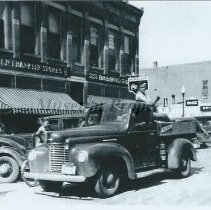Object Record
Images

Metadata
Object Name |
Truck |
Source |
Mount Ayr Depot Museum |
Iowa History Era Tag |
World War II to an Urban State (1940-1963) |
Chronological Tag |
Postwar United States (1945-1970s) |
Catalog Number |
2018.021.071 |
Credit line |
Mount Ayr Depot Museum - Mount Ayr, Iowa |
Description |
This photograph shows the north side of the Mount Ayr town square in the mid-1940s. The truck in the middle of the street is a Mount Ayr Mill & Feed delivery truck. Three different Coca-Cola signs can also be seen in the photo. Content can be used with the following standards: 4th grade SS 4.26 Changes to Agriculture and SS-Econ. 9-12.24 Iowa Impact Upon Economy in a lesson on agriculture and companies during the Great Depression period. For any use other than instructional resources, please check with the organization that owns this item regarding copyright restrictions. |
Additional Research & Sources |
Started by Tennant and Anderson, the Mount Ayr Mill and Feed specialized in two types of milling. The first was table-use milling, which provided cornmeal, buckwheat flour and cracked wheat for breakfast foods that would later be sold at surrounding local grocery stores. The second type was to produce animal feed which was made with a hammer mill or feed mixer. These were collected into stamped or printed sacks for sale. Despite low sales during the Depression years, the company was able to stay open and continue their business. In 1937, Tennant and Anderson partnered with Nutrena Feed and continued to work six days a week with a total of only five employees (as of 1937). |
Primary/Secondary Source |
Significant - Local |
County Tag |
Ringgold |
Relation |
Show Related Records... |
Multimedia Links |
Click here to view/hear the file. |
Search Terms |
Agriculture Business & Industry Towns Types of Business and Industries Town square Transportation Automobiles Bicycles & tricycles Coca-Cola |
Legal Status |
Ownership of this resource is held by the Mount Ayr Depot Museum and has been provided here for educational purposes only, specifically for use in the Iowa Museum Association's "Teaching Iowa History" project. It may not be downloaded, reproduced or distributed in any format without written permission from the Rights Holder. For information on U.S. and International copyright laws, consult an attorney. |
